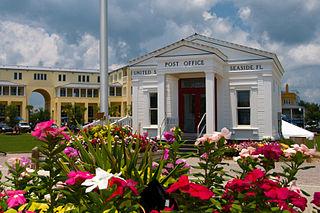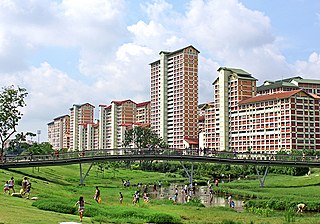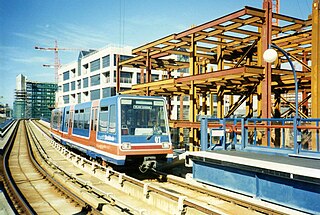Related Research Articles

New Urbanism is an urban design movement which promotes environmentally friendly habits by creating walkable neighborhoods containing a wide range of housing and job types. It arose in the United States in the early 1980s, and has gradually influenced many aspects of real estate development, urban planning, and municipal land-use strategies. New urbanism attempts to address the ills associated with urban sprawl and post-Second World War suburban development.

Public housing is a form of housing tenure in which the property is usually owned by a government authority, either central or local.

Urban renewal is a program of land redevelopment often used to address urban decay in cities. Urban renewal is the clearing out of blighted areas in inner cities to clear out slums and create opportunities for higher class housing, businesses, and more. A primary purpose of urban renewal is to restore economic viability to a given area by attracting external private and public investment and by encouraging business start-ups and survival.

Centenary Square is a public square on the north side of Broad Street in Birmingham, England, named in 1989 to commemorate the centenary of Birmingham achieving city status. The area was an industrial area of small workshops and canal wharves before it was purchased by the council in the 1920s for the creation of a grand civic centre scheme to include museums, council offices, cathedral and opera house. The scheme was abandoned after the arrival of World War II with only the Hall of Memory and half of the planned Baskerville House complete. After the war the scheme was revived in a simpler form however the council never managed to implement the design.

The London Docklands Development Corporation (LDDC) was a quango agency set up by the UK Government in 1981 to regenerate the depressed Docklands area of east London. During its seventeen-year existence it was responsible for regenerating an area of 8.5 square miles (22 km2) in the London Boroughs of Newham, Tower Hamlets and Southwark. LDDC helped to create Canary Wharf, Surrey Quays shopping centre, London City Airport, ExCeL Exhibition Centre, London Arena and the Docklands Light Railway, bringing more than 120,000 new jobs to the Docklands and making the area highly sought after for housing. Although initially fiercely resisted by local councils and residents, today it is generally regarded as having been a success and is now used as an exemplar of large-scale regeneration, although tensions between older and more recent residents remain.

Brindleyplace is a large mixed-use canalside development, in the Westside district of Birmingham, England. It was named after Brindley Place, the name of the street around which it is built. It was developed by the Argent Group from 1993 onwards. In addition to shops, bars and restaurants, Brindleyplace is home to the National Sea Life Centre, Royal Bank of Scotland, Orion Media, Ikon Gallery of art and the Crescent Theatre. The site covers 17 acres (69,000
Duddeston is an inner-city area of the Nechells ward of central Birmingham, England. It was part of the Birmingham Duddeston constituency until that ceased to exist in 1950.

Tyburn is a ward in Birmingham, England formerly known as Kingsbury.

The Big City Plan is a major development plan for the city centre of Birmingham, England.

The Jewellery Quarter is an area of central Birmingham, UK, in the north-western area of Birmingham City Centre, with a population of around 19,000 people in a 1.07-square-kilometre (264-acre) area.

Nechells is a district ward in central Birmingham, England, whose population in 2011 was 33,957. It is also a ward within the formal district of Ladywood. Nechells local government ward includes areas, for example parts of Birmingham city centre, which are not part of the historic district of Nechells as such, now often referred to in policy documents as "North Nechells, Bloomsbury and Duddeston".

Star City is a family leisure and entertainment complex in Nechells, Birmingham, England. It is located in the north east of the city very close to Junction 6 of the M6 motorway, and Aston railway station.

The Teesside Development Corporation was a government-backed development corporation that was established in 1987 to fund and manage regeneration projects in the former county of Cleveland in North East England.
The water and sanitation sector in Peru has made important advances in the last two decades, including the increase of water coverage from 30% to 85% between 1980 and 2010. Sanitation coverage has also increased from 9% to 37% from 1985 to 2010 in rural areas. Advances have also been achieved concerning the disinfection of drinking water and in sewage treatment. Nevertheless, many challenges remain, such as:

The water supply and sanitation in India has increased greatly from 1980 to present. Still, many people lack access to clean water, toilets, and sewage infrastructure. Various government programs at national, state, and community level have brought rapid improvements in sanitation and the drinking water supply. These various programs are ongoing.

Colmore Row is a street in Birmingham City Centre in the centre of Birmingham, England, running from Victoria Square to just beyond Snow Hill station. It is traditionally the city's most prestigious business address.
Birmingham city centre, also known as Central Birmingham and often known locally as town, is the central business district of Birmingham, England. Following the removal of the Inner Ring Road, the city centre is now defined as being the area within the Middle Ring Road. The city centre is undergoing massive redevelopment with the Big City Plan, which means there are now nine emerging districts and the city centre is approximately five times bigger.

Water supply and sanitation in Mozambique is characterized by low levels of access to an at least basic water source, low levels of access to at least basic sanitation and mostly poor service quality. In 2007 the government has defined a strategy for water supply and sanitation in rural areas, where 62% of the population lives. In urban areas, water is supplied by informal small-scale providers and by formal providers.
Non-profit housing developers build affordable housing for individuals under-served by the private market. The non-profit housing sector is composed of community development corporations (CDC) and national and regional non-profit housing organizations whose mission is to provide for the needy, the elderly, working households, and others that the private housing market does not adequately serve. Of the total 4.6 million units in the social housing sector, non-profit developers have produced approximately 1.547 million units, or roughly one-third of the total stock. Since non-profit developers seldom have the financial resources or access to capital that for-profit entities do, they often use multiple layers of financing, usually from a variety of sources for both development and operation of these affordable housing units.

The Housing and Urban Development Act of 1968, Pub.L. 90–448, 82 Stat. 476, enacted August 1, 1968, was passed during the Lyndon B. Johnson Administration. The act came on the heels of major riots across cities throughout the U.S. in 1967, the assassination of Civil Rights Leader Martin Luther King Jr. in April 1968, and the publication of the report of the Kerner Commission, which recommended major expansions in public funding and support of urban areas. President Lyndon B. Johnson referred to the legislation as one of the most significant laws ever passed in the U.S., due to its scale and ambition. The act's declared intention was constructing or rehabilitating 26 million housing units, 6 million of these for low- and moderate-income families, over the next 10 years.
References
- 1 2 3 4 Michael Pacione (1999). Applied Geography: Principles and Practice . Routledge. pp. 317–8. ISBN 0-415-18268-9.
- 1 2 3 4 5 Peter Newman; Andy Thornley (1996). Urban Planning in Europe: International Competition, National Systems & Planning Projects . Routledge. pp. 132–3. ISBN 0-415-11178-1.
- ↑ Royce Logan Turner (1995). The British Economy in Transition: From the Old to the New? . Routledge. p. 206. ISBN 0-415-11114-5.
- ↑ David Adams (1994). Urban Planning and the Development Process. Routledge. p. 147. ISBN 1-85728-021-0.
- ↑ Michael Heseltine (12 September 2000). "The Birmingham Heartlands Development Corporation (Planning Functions) Order 1992". Office of Public Sector Information (OPSI). Retrieved 6 June 2008.
- ↑ David Chapman (1996). Creating Neighbourhoods and Places in the Built Environment. Taylor & Francis. p. 213. ISBN 0-419-20930-1.
- ↑ National Audit Office report dated 27 February 2002.
- ↑ "The Urban Development Corporations in England (Dissolution) Order 1998". Government of the United Kingdom. Retrieved 28 August 2018.